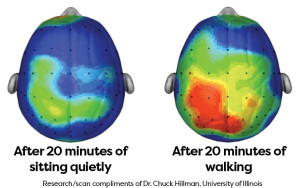Exercise, and get smarter while you’re at it!
Research provides strong evidence for a positive link between exercise and cognitive function.
 The most comprehensive review of the published literature on exercise and academic performance to date, published by the US Centers for Disease Control and Prevention, found: “The majority of these articles (86%) found at least one positive association with academic behavior outcomes. Given these findings, physical activity interventions may offer one approach to improving academic behaviors (e.g., classroom conduct) in some youth.” [1]
The most comprehensive review of the published literature on exercise and academic performance to date, published by the US Centers for Disease Control and Prevention, found: “The majority of these articles (86%) found at least one positive association with academic behavior outcomes. Given these findings, physical activity interventions may offer one approach to improving academic behaviors (e.g., classroom conduct) in some youth.” [1]
A significant positive relationship…between physical activity and cognitive function in children aged 4-18 years. [Physical activity] improves a youth’s perceptual skills, intelligence quotient, achievement, verbal tests, mathematic test, developmental level and academic readiness. [2]
Findings with brain function in youth clearly indicate that exercise early in a person’s life can be of great magnitude for the improvement of cognitive health during childhood and this may extend throughout one’s adult lifespan. [3]
“Memory retention and learning functions are all about brain cells actually changing, growing, and working better together,” says John J. Ratey, clinical associate professor of psychiatry at Harvard Medical School and the author of Spark: The Revolutionary New Science of Exercise and the Brain. “Exercise creates the best environment for that process to occur.” [4]
In a 2007 study published in the Journal of Sport & Exercise Psychology, Charles Hillman, associate professor of kinesiology and neuroscience at the University of Illinois, put 259 Illinois third graders and fifth graders through standard physical education routines such as push-ups and a timed run, and he measured their body mass. Then he checked their physical results against their math and reading scores on the Illinois Standards Achievement Test. “There was a relationship to academic performance,” says Hillman. “The more physical tests they passed, the better they scored on the achievement test.” The effects appeared regardless of gender and socioeconomic differences, so it seems that regardless of his or her race or family income, the fitness of a child’s body and mind are tightly linked. [5]
Phillip Tomporowski, professor of exercise science at the University of Georgia, says much of the research today seems to negate the old notion that recess sends kids back to class more hyper and rowdy. “It appears to be the other way around,” he says. “They go back to class less boisterous, more attentive, and better behaved compared with kids who have been sitting in chairs for hours on end.” [6]
We have eyelids but not earflaps!
The research behind why listening should be incorporated into the school day.
As a presentation medium, listening offers teachers a means to differentiate content, in terms of both medium and difficulty. For students who may lack skill or interest in text, listening is a beneficial alternative for content delivery, supporting access and learning. Student engagement is foundational to successfully differentiating instruction and in this respect, listening may prove indispensable, relating learning to the medium and technologies that now predominate students’ social and recreational lives. [7]
Technology has raised the importance of listening, as students live now in a sea of oral language and sound. Digital natives listen to learn. While some schools have moved to employ new media in the classroom, most continue to emphasize learning almost exclusively from printed text. This creates a tremendous gap between the learning technologies students use and the way in which academic content is delivered. [8]
Recent brain research has revealed an important finding: when individuals are engaged in active, strategic listening, they use the same executive functions in the prefrontal cortex that are engaged during active, strategic reading. This finding from the neurosciences confirms an important relationship: the same strategies and skills that allow a listener to make sense of oral language – predicting, monitoring, connection to background knowledge and summarizing – allow a reader to make sense of written language. Listening comprehension is critical to reading comprehension because listening and reading require the same strategies. [9]
Audio books allow children to experience written language without the burden of decoding, granting them access to content that they may not be able read and understand by themselves. Audio books provide students with exposure to a great variety of words in context, and with proper pronunciation, dialect and fluency. Audio books help students stretch their reading abilities since they can listen a full two grade levels beyond their current reading level. [10]
Footnotes:
[1] The Association between School-Based Physical Activity, Including Physical Education, and Academic
[2] Sibley BA, Etnier JL. The relationship between physical activity and cognition in children: A meta-analysis. Pediatric Exercise Science 2003; 15:243-256.
[3] Hillman, C.H., Erickson, K.I, and Kramer, A.F. (2008). Be smart, exercise your heart: exercise effects on brain and cognition. Nature Review Neuroscience, 9(1), 58-65.
[4] A Fit Body Means a Fit Mind; (Edutopia 2009)
[5] Ibid
[6] Ibid
[7] Supporting Differentiated Instruction with Listening (CAST 2006)
[8] Ibid
[9] “Plato Revisited: Learning Through Listening in the Digital World” CAST 2007
[10] The Common Core State Standards, English Language Arts (Appendix A)

